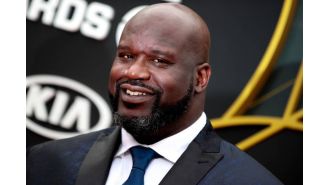Aging Machines, Crowds, Humidity: Problems at the Polls Were Mundane but Widespread
Instead of fireworks from voter intimidation or cyberattacks, Americans grappled with the mundane frustrations of using dated equipment to vote in huge numbers.

If the defining risk of Election Day 2016 was a foreign meddling, 2018ŌĆÖs seems to have been a domestic overload. High turnout across the country threw existing problems ŌĆö aging machines, poorly trained poll workers and a hot political landscape ŌĆö into sharp relief.
Michael McDonald, a political science professor at the University of Florida who studies turnout, says early numbers indicate TuesdayŌĆÖs midterm saw the highest percentage turnout since the mid-ŌĆÖ60s. ŌĆ£All signs indicate that everyone is now engaged in this country ŌĆö Republicans and Democrats,ŌĆØ he said, adding that he expects 2020 to also be a year of high turnout. ŌĆ£Election officials need to start planning for that now, and hopefully elected officials who hold the purse strings will be responsive to those needs.ŌĆØ
Electionland monitored problems across the country on Election Day, supporting the work of 250 local journalists in more than 120 local newsrooms. Thousands of voters reported issues at the polls, and Electionland sought to report on as many as possible. The most striking problem of the night was perhaps the most predictable ŌĆö aged or ineffective voting equipment caused hourslong lines across the country.
American voting hasnŌĆÖt had a major technology refresh since the early 2000s, in the aftermath of the Florida recount and the passage of the 2002 Help America Vote Act, which infused billions of dollars into American elections. More recent upgrades, such as poll books that could be accessed via computer, were supposed to reduce bottlenecks at check-ins ŌĆö but they repeatedly failed on Tuesday, worsening waits in Georgia, South Carolina and Indiana.
While aging infrastructure was already a well-known problem to election administrators, the surge of voters experiencing ordinary glitches led to extraordinarily long waits, sometimes stretching over hours. From Pennsylvania to Georgia to Arizona and Michigan, polling places started the day with broken machines leading to long lines, and never recovered.
ŌĆ£In 2016, we learned the technology has security vulnerabilities. Today was a wake-up call to performance vulnerabilities,ŌĆØ said Trey Grayson, the former president of the National Association of Secretaries of State and a member of the 2013 Presidential Commission on Election Administration. Tuesday, Grayson said, showed ŌĆ£the implications of turnout, stressing the system, revealing planning failures, feel impact of limited resources. If you had more resources, youŌĆÖd have had more paper ballots, more machines, more polling places.ŌĆØ
The election hotline from the LawyersŌĆÖ Committee for Civil Rights Under Law clocked 24,000 calls by 6 p.m., twice the rate in in the 2014 midterm election. ŌĆ£People were not able to vote because of technical issues that are completely avoidable,ŌĆØ Ryan Snow, of the LawyersŌĆÖ Committee, said. ŌĆ£People who came to vote ŌĆö registered to vote, showed up to vote ŌĆö were not able to vote.ŌĆØ
ŌĆ£We think we can solve all of these voting problems by adding technology, but you have to have a contingency plan for when each of these pieces fail,ŌĆØ said Joseph Lorenzo Hall, the chief technologist at the Center for Democracy & Technology in Washington, D.C. It appears many of the places that saw electronic poll book failures had no viable backup system.
Hall said that problems with machines and computers force election administrators to become technicians on the spot, despite their lack of training. This exacerbates problems: Poll workers arenŌĆÖt able to accurately or efficiently report issues to their central offices, leading to delays in dispatches of appropriate equipment or staff.
Perhaps the most embarrassing technological faceplant was in New York City, where the machines used to scan ballots proved no match for wet weather. Humidity caused the scanners to malfunction, leading to outages and long lines.
The breakdowns proliferated up and down the East Coast. Humidity also roiled scanners in North Carolina. In Charleston, South Carolina, an interminable delay driven by a downed voting system drove one person to leave for work before she could cast her ballot. ŌĆ£It felt like a type of disenfranchisement,ŌĆØ she told ProPublica. Voting machine outages in some Georgia precincts stranded voters in hourslong lines. In predominantly black sections of St. Petersburg, Florida, wait times ballooned as voting machines froze.
Some of the pressure on the aging technology was relieved by early and mail-in voting, so that everyone didnŌĆÖt have to vote on the same day, Grayson said. But many states still require people to cast their ballots on Election Day, and others have added time-consuming procedures such as strict ID requirements.
Those sorts of security measures add their own layers of confusion. Many voters reported never receiving their ballots in the mail. Georgia voter Shelley Martin couldnŌĆÖt vote because her ballot was mailed to the wrong address ŌĆö even though she filled out her address correctly, the county election office accidentally changed a 9 to a 0. In Ohio, some in-person voters were incorrectly told they had already received an absentee ballot, because of a computer error.
When people show up at the wrong polling place or have problems with their registration, they are usually entitled to cast a provisional ballot that will be counted once itŌĆÖs verified. But these problems were so common on Tuesday that some locations ran out of provisional ballots and turned people away, according to North Carolina votersŌĆÖ reports to ProPublica. In Arizona, some voters were told they couldnŌĆÖt have provisional ballots because of broken printers. In Pennsylvania, some college students encountered glitches with their registration and said poll workers wouldnŌĆÖt give them provisional ballots.
A newly implemented law in North Dakota left a handful of college students ŌĆö many of whom had voted in previous elections ŌĆö confused and unable to vote. ŌĆ£I was so frustrated because IŌĆÖve voted in North Dakota before,ŌĆØ said Alissa Maesse, a student at the University of North Dakota who came to the polls with a Minnesota driverŌĆÖs license and bank statement with a North Dakota address, but needed a North Dakota driverŌĆÖs license, identification card or tribal ID. ŌĆ£I canŌĆÖt participate at all and I wanted to.ŌĆØ
Administrative stumbling blocks and unhelpful election officials left some voters throughout the day scrambling to figure out where or how they were supposed to vote. Across the country, confusion over new laws and poll worker error forced voters to work with attorneys or drive long distances in an attempt to solve problems.
In Missouri, a last-minute court ruling resulted in chaos across the state. Less than a month before, a judge radically altered the stateŌĆÖs voter ID law to allow more valid forms of identification. By then, poll workers had already been trained. Many enforced the incorrect version of the law.
In St. Charles County, northwest of St. Louis, voters across the county reported that poll workers openly argued with voters who showed identification allowed under the new ruling, demanding old forms of ID. By the end of the evening, the county had ignored demand letters from attorneys at Advancement Project, a civil rights group. Denise Lieberman, an attorney with the group, said it is considering legal remedies due to the countyŌĆÖs ŌĆ£flagrant disregardŌĆØ for the judgeŌĆÖs ruling.
Rich Chrismer, the director of elections for the county, said he never saw the letters ŌĆö he was at polling places all day. By late morning, heŌĆÖd been made aware of 12 different polling locations where poll workers were giving incorrect instructions. He utilized the local police to distribute memos to all 121 polling locations, correcting poll worker instructions. They were distributed by the late morning, and complaints dropped off after that, he said.
Chrismer said training had already happened by the time the judge issued his ruling, but that heŌĆÖd put new instructions in ŌĆ£four different placesŌĆØ in the packet mailed to poll workers ahead of the election. ŌĆ£They were either ignoring me or they didnŌĆÖt know how to read, which upsets me,ŌĆØ he said.
Dallas County Clerk Stephanie Hendricks expressed similar frustration at the short window of time allowed by the court to retrain poll workers, update signs and ensure voter understanding.
Hendricks said the small county had to ŌĆ£scrape the bottom of the barrelŌĆØ for poll workers, who only received 90 minutes of training. This, combined with the very short notice for the legal change, made it difficult to help poll workers understand the law. ŌĆ£The last few elections itŌĆÖs been photo ID, photo ID, photo ID, and now all of a sudden the brakes have been thrown on. ItŌĆÖs confusing for people,ŌĆØ she said.
The frustrations for Chris Sears began on Friday, when he turned up to cast an early ballot at Cinco Ranch Public Library, a brick building abutting a duck pond in the suburbs west of Houston. Sears, a 43-year-old Texan who works in real estate, had voted at the library in the 2016 election, after moving to the area from adjoining Harris County a year earlier. Now, at the library, poll workers couldnŌĆÖt find him in their rolls. His only recourse, they told him, was to drive the half hour or so to the Fort Bend County election office. Sears, realizing he wouldnŌĆÖt make it there and back before early voting closed, decided to go first thing Tuesday morning.
After he explained his situation and presented his driverŌĆÖs license, which had a local address, the clerk at the election office had a terse message for him. She slid a fresh voter registration application across the counter and told him: ŌĆ£Fill this out, and youŌĆÖll be eligible to vote in the next election.ŌĆØ Sears told the clerk he hadnŌĆÖt moved, and that heŌĆÖd voted in the last election.
The clerk was unmoved. ŌĆ£What you can do,ŌĆØ the clerk repeated, pointing at the registration form, ŌĆ£is fill this out, and vote in the next election.ŌĆØ
Sears wasnŌĆÖt alone. As he went back and forth with the clerk, three other men who, like Sears, had moved recently from other Texas counties, came in with near-identical complaints. The clerk gave them the same response she had given Sears. County officials told ProPublica they all should have been offered provisional ballots ŌĆö not sent across town or told to register again.
Ultimately, Sears would cast a provisional ballot, but he didnŌĆÖt discover this option until heŌĆÖd done hours of research to try and hunt down the cause of his problems.
ŌĆ£I finally got to vote,ŌĆØ he said. ŌĆ£But that was after driving across two counties and spending five or six hours of my time trying to determine whether there was a way I could do it.ŌĆØ
Some administrative problems were a bit more bizarre ŌĆö a polling place in Chandler, Arizona, was foreclosed upon overnight. Voter Joann Swain arrived at the Golf Academy of America, which housed the poll, to find TV news crews and a crowd of people in the parking lot of the type of faux Spanish Mission Revival shopping centers that fleck the desert around Phoenix. Voting booths were arrayed along the sidewalk.
A sign affixed to the buildingŌĆÖs locked front door indicated that the landlord has foreclosed on the Golf Academy for failing to pay rent. While poll workers had set up the voting booths the night before, that didnŌĆÖt appear to matter to the landlord. The sign read: ŌĆ£UNAUTHORIZED ENTRY UPON THESE PREMISES OR THE REMOVAL OF PROPERTY HEREFROM MAY RESULT IN CRIMINAL AND/OR CIVIL PROSECUTION.ŌĆØ
The timing struck Swain as suspect. ŌĆ£Were they trying to make it more difficult for people to vote?ŌĆØ she asked Wednesday. Election officials had provided no answers. ŌĆ£ItŌĆÖs just fishy.ŌĆØ
Swain, who is 47, waited in line for two hours as poll workers promised the machines necessary for voters to print and cast their ballot were on their way from Phoenix. She didnŌĆÖt want to cast a provisional ballot, for fear it wouldnŌĆÖt be counted. One man in line who took poll workers up on an alternative to waiting ŌĆö voting at Chandler City Hall ŌĆö returned not long after he left. With polling site difficulties cropping up throughout the Phoenix area, he hadnŌĆÖt been able to vote there either.
To the puzzlement of voters waiting in line, Maricopa County Recorder Adrian Fontes tweeted that the Golf Academy polling place was open. ŌĆ£No itŌĆÖs not. IŌĆÖm here,ŌĆØ an Arizonan named Gary Taylor shot back.
Other voters reacted to situation more volubly. ŌĆ£I got things to do. I canŌĆÖt stand around all day waiting because these guys canŌĆÖt do their job,ŌĆØ a voter named Thomas Wood told reporters. ŌĆ£ItŌĆÖs ridiculous. ItŌĆÖs absolutely ridiculous.ŌĆØ
Swain ultimately left at 8:30 a.m. By the time she returned, later in the day, poll workers had set up the voting machines delivered from Phoenix in another storefront in the shopping center. The original machines remained locked in the Golf Academy, she said.
Back East, reports of potentially improper political messages at polling sites had begun to crop up, and the response from election officials highlighted the at times flimsy nature of electioneering laws. On Tuesday morning, a handwritten sign appeared on the door of a polling station near downtown Pittsburgh, which read ŌĆ£Vote Straight Democrat.ŌĆØ County election officials were alerted to the sign in the early afternoon, but by then the sign had been removed, Amie Downs, an Allegheny County spokeswoman, said in a statement.
An official in the county election office, who declined to give her name, blamed the sign on a member of the local Democratic Party committee. ŌĆ£He said he does that every year but never had problems till this year,ŌĆØ she said. Pennsylvania law prohibits electioneering within 10 feet of a polling place, and Downs said it wasnŌĆÖt clear whether the sign violated the law.
Down the coast, in New Port Richey ŌĆö a politically mixed cluster of strip malls northwest of Tampa, Florida ŌĆö Pastor Al Carlisle triggered upward of 75 complaints to Pasco County election officials after he put up a handwritten sign reading ŌĆ£DonŌĆÖt Vote for Democrats on Tuesday and Sing ŌĆśOh How I Love JesusŌĆÖ on SundayŌĆØ outside his church. That wouldnŌĆÖt be a problem, except that on Election Day, his church doubles as a polling place. Carlisle remained unrepentant. He continued Wednesday to trumpet the sign on his Facebook page, mixed among posts conflating religious faith with support for President Donald Trump.
Local election officials, however, stopped at mild censure. Pasco County election chief Brian Corley told the Tampa Bay Times the sign was ŌĆ£not appropriateŌĆØ but legal, since Carlisle had placed it only just more than 100 feet away from where voters were casting their ballot.
Later in the day, some voters complained about large posters opposing abortion ŌĆö an example: ŌĆ£God DoesnŌĆÖt Make Mistakes, Choose LifeŌĆØ ŌĆö plastered on the walls of a church gymnasium in Holts Summit, Missouri, used as a polling place. Despite the political implications, election officials told local radio station KBIA that the posters were legal because there were no abortion-related issues on the ballot.
Behind the scenes, officials nationwide were addressing gaps in website reliability and security. In Kentucky, a handful of county websites that provided information to voters flickered offline for parts of the day. State officials said the issue was likely a technical problem not caused by a malicious attack.
But several states meanwhile alerted U.S. election-security officials to efforts of hackers scanning their computer systems for software vulnerabilities. Days before the election, a county clerkŌĆÖs office said its email account was compromised and its messages forwarded to a private Gmail address, according to person familiar with the matter who was not authorized to discuss it publicly.
As polls closed Tuesday evening, back in New York, the crowds and ballot scanner failures remained. At one school in Brooklyn that had seen long lines in the morning, the wait to vote at 7 p.m. was no better ŌĆö still upward of two hours, Emily Chen told ProPublica. By the end of the day, the New York City Council speaker had called for the elections directorŌĆÖs resignation, and the mayor had denounced the technical snags as ŌĆ£absolutely unacceptable.ŌĆØ
Down the coast, in Broward County, Florida, just north of Miami, election officials were struggling with a technical failure of a different sort. Seven precincts were unable to transmit vote tallies electronically. This time, it would force election officials to internalize what voters had suffered throughout much of the day. Around 11 p.m., they walked out into the balmy South Florida night, got into their cars and drove the voter files to the county election office.






